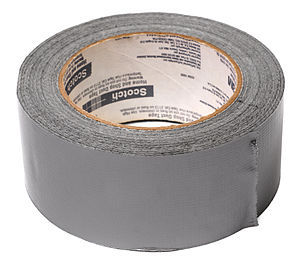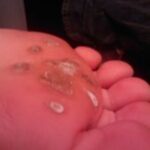A plantar wart is a wart on the sole of the foot. Unlike a corn or callus, a wart usually has tiny black dots on it that are places where the wart caused bleeding into the skin. What causes plantar warts? They are the skin’s reaction to a virus called Human Papilloma Virus. Different strains of the virus cause warts in different locations on the body. A plantar wart can be uncomfortable if you have to walk or stand on it. Amazingly, for most patients, the best treatment for plantar warts is probably a treatment you can do at home. Here are your options:
1) Salicylic acid (available as Mediplast, Wart Off, Dr. Scholl’s and generic brands). Salicylic acid is naturally occurring acid (originally extracted from willow bark). Many studies show that salicylic acid is more effective than placebo in treating plantar warts. It is, in fact, the most effective treatment for plantar warts known to modern medicine. In this treatment, you soak the wart for about 20 minutes in warm water. Then you apply the salicylic acid (plaster or pad) to the wart overnight. You may have to cut the plaster to fit your wart. You want it to fit as exactly as possible because it is, after all, an acid. Sometimes a hole punch is helpful. In the morning, you remove the plaster or pad and use a loofah, pumice stone, or emery board to remove the dead skin. You repeat these steps nightly until the wart is gone.
2) Duct tape. In two small clinical trials in children, duct tape was found to be more effective than placebo, while a third study found duct tape was not more effective than placebo when used on adults. In this treatment, you use any color duct tape (the trials which showed effectiveness used silver) to cover the wart for 6 days. On the 7th day, soak the wart for 20 minutes in warm water, and then remove the dead skin using a loofah sponge, emery board or pumice stone. This cycle is repeated until the wart goes away. Some people are irritated by or have allergic reactions to duct tape.
3) Do nothing. Some warts go away on their own depending on your immune reaction to the wart. In the meantime, you can make yourself more comfortable by using a donut shaped pad, or moleskin around the wart to cushion the area. Beware, though. The body’s response to a wart is tricky to predict and it may be months or years before the wart goes away. Still, if the wart is small and isn’t bothering you, its perfectly fine to leave it alone.
Some patients worry that a wart they can still see is contagious. However, no matter what removal method is used, the virus is never completely destroyed. If you leave it on the skin to get better on its own, you are not any more contagious than you would be if you had it removed.
4) Wart freezing kit. Though freezing a wart off sounds like it would be very effective, it is not more effective than salicylic acid for plantar warts, and has more possibilities for serious side effects, such as scarring and pain of the foot. Though the actual treatment numbs the area, the numbing process is uncomfortable and, after thawing, the area can be fairly painful as well. Over the counter freezing kits are best reserved for warts on other body parts.
When you should see a doctor for a wart. Sometimes its better to see a doctor rather than wait for home treatment to work. You should see a doctor for supervised treatment if you are diabetic, or if you have poor circulation, foot numbness or a severely compromised immune system (like AIDS). Also, preverbal children may benefit from seeing a doctor for supervised treatment.
You should also see a doctor if you’re not sure you have a wart, the wart is getting much larger, you suspect that the area is infected (increasing pain, redness, or pus), home treatment isn’t successful after 3 months, or you can’t wait and want to have the wart surgically removed or frozen. Your doctor can treat you with a variety of other treatments as well. Though none of these are as effective as salicylic acid or as harmless as duct tape/moleskin, some warts respond better to some treatments than others.
References:
De Haen, M., M. G. Spigt, C. J. T. Van Uden, P. Van Neer, F. J. M. Feron, and A. Knottnerus. “Efficacy of Duct Tape vs Placebo in the Treatment of Verruca Vulgaris (Warts) in Primary School Children.” Archives of Pediatrics and Adolescent Medicine 160.11 (2006): 1121-125. Print.
Foscht, D. R., III, C. Spicer, and M. P. Fairchok. “The Efficacy of Duct Tape vs Cryotherapy in the Treatment of Verruca Vulgaris.” Archives of Pediatric and Adolescent Medicine 156.10 (2002): 971-74. Print.
Mulhem, Elie, and Susanna Pinelis. “Treatment of Nongenital Cutaneous Warts.” American Family Physician 84.3 (2011): 288-93. Print.
Wenner, R., S. K. Askari, P. M. H. Cham, D. A. Kedrowski, A. Liu, and E. M. Warshaw. “Duct Tape for the Treatment of Common Warts in Adults: A Double-blind Randomized Controlled Trial.” Archives of Dermatology 143.3 (2007): 309-13. Print.





